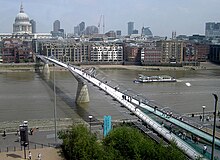Millennium Bridge (London)





The Millennium Bridge is a pedestrian bridge over the River Thames in London . It connects the City of London on the north side with the district of Southwark in the London Borough of Southwark on the south side. The bridge is owned by Bridge House Estates , a City of London Corporation charity .
At the north end of the bridge are St Paul's Cathedral and the City of London School , at the south end the Tate Modern , Globe Theater and Bankside Gallery . The suspension bridge is anchored in the ground so that one can enjoy an unrestricted view of St Paul's Cathedral from the south bank.
draft
In 1996 the Southwark Borough Council held an architectural competition. The winning project came from Norman Foster (designer), Arup (engineering office), Chris Wise (Arup engineer for the original plans) and Anthony Caro . Due to the restriction of the height and to improve the view, the suspension ropes are located next to the footpath, which makes the suspension bridge appear unusually flat. The bridge stands on two pillars and has three sections with a length of 81, 144 and 108 meters (from north to south); the total length of the bridge is 325 meters. The eight suspension ropes can carry a weight of 2000 tons, so 5000 people can be on the bridge at the same time.
history
Preparatory work began in July 1998, with main work on April 28, 1999. The bridge cost £ 18.2 million (2.2 million over budget) and opened on June 10, 2000 two months late. Only two days later it had to be closed again to the public due to uncontrolled violent swaying. These were essentially lateral movements. The vertical movements, however, remained within the pre-calculated framework. The bridge was nicknamed The wobbly bridge by the residents of London .
Extensive theoretical investigations and practical tests resulted in the following explanation:
The first natural frequency for transverse vibrations of the bridge is around 1 Hertz . It is therefore entirely possible for pedestrians to make them vibrate. In general, people on a bridge do not walk in lockstep. However, if the bridge happens to vibrate laterally, people adapt to this vibration and try to compensate for it through their own movements, much like a sailor moves on a swaying ship. This means that they move uniformly and thus increase the vibration. This happens largely unconsciously. Only when the vibrations have become so great that they are perceived as uncomfortable or threatening do people stop and, if possible, hold on to the railing. This stops the vibration.
In the following two years, a special damper system was built into the Millennium Bridge for the renovation. This essentially consists of dampers laid diagonally under some bridge fields and a total of 58 vibration absorbers that were connected horizontally and vertically to the bridge. The bridge retrofit cost £ 5 million. The work on the corrections was directed by Arup Tony Fitzpatrick.
On February 22, 2002, the Millennium Bridge was reopened to the public. The experience with the unexpected “life of its own” of the bridge led to extensive follow-up examinations of other bridge constructions, since up to the year 2000 not enough attention was paid to the horizontal vibrations in this form in bridge construction.
In March 2008, the Millennium Bridge was closed for two days to film the film Harry Potter and the Half-Blood Prince ; in the film the bridge is destroyed.
literature
- Tony Fitzpatrick et al. a .: Linking London: The Millennium Bridge . Royal Academy of Engineering (Ed.), London 2001, ISBN 1-871634-99-7 .
Web links
- Millennium Bridge (London). In: Structurae
- www.wissenschaft.de: The secret of the swaying Millennium Bridge in London
- GERB vibration isolation, further information on the vibration absorbers used
- Explanation of the calculation error
- Small report on the "Harry Potter" filming on the Millennium Bridge
Individual evidence
- ↑ Revealed: Why the wobbly bridge wobbled (accessed October 9, 2011)
- ↑ £ 5m bill to damp down bridge's bounce
- ↑ bridgeweb.com: Death of Tony Fitzpatrick
|
upriver Blackfriars Railway Bridge |
River crossings of the Thames |
downstream Southwark Bridge |
Coordinates: 51 ° 30 ′ 35 " N , 0 ° 5 ′ 54" W.